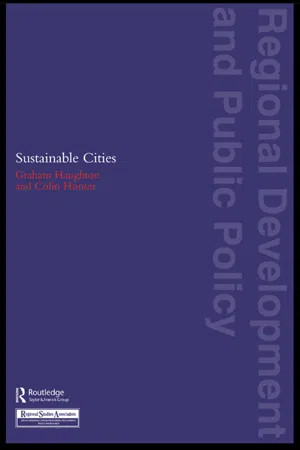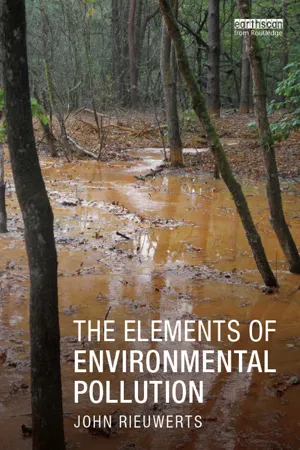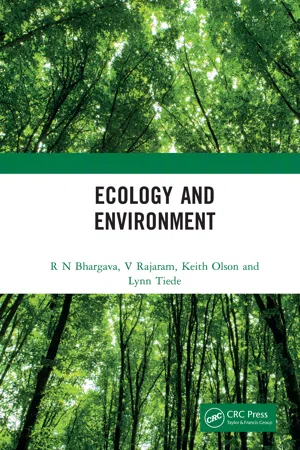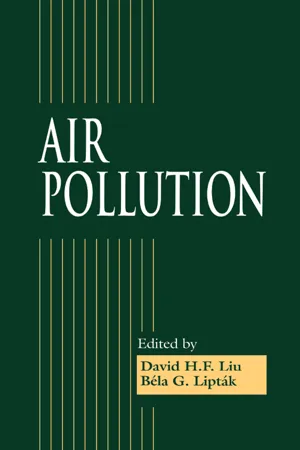Geography
Pollutants
Pollutants are substances or energy forms that, when introduced into the environment, can cause harm or discomfort to living organisms or disrupt the natural balance of ecosystems. They can be in the form of chemicals, particulates, or biological materials and are often the result of human activities such as industrial processes, transportation, and agriculture.
Written by Perlego with AI-assistance
Related key terms
5 Key excerpts on "Pollutants"
- eBook - ePub
- Graham Haughton, Colin Hunter(Authors)
- 2004(Publication Date)
- Routledge(Publisher)
There are a number of reasons for this focus on air and water pollution. Air and water are clearly fundamental resources for life on Earth. The degradation of these resources via numerous forms of pollution is, arguably, the most significant threat to the integrity of the Earth’s ecological balance and the sustainable use of its resources. It is slowly becoming accepted that human societies cannot rely on nature to provide a continuous supply of clean air and water to sustain human activities, whilst at the same time expecting these resources to absorb and neutralise the waste products of human activities cheaply and effectively. Moreover, cities, as centres of resource consumption and waste production, exert an influence over the contamination of air and water which is greatly disproportionate to their physical size. Cities are, therefore, responsible for very many air and water pollution problems, both within and beyond urban boundaries. Furthermore, pollution arises from many different activities (e.g. energy production, transport, industry, domestic waste disposal etc.) and as such provides a useful insight into the range of human endeavours which impact on the quality and functioning of the natural environment. Finally, the sources and effects of air and water pollution, although very far from being fully understood and appreciated, have been widely investigated around the world. These studies have contributed to a growing disquiet concerning pollution impacts on human health and the functioning of natural ecosystems. At present, much of the world’s pollution is sourced in the developed countries; the North, with 25% of the world’s population, consumes 70% of the world’s energy, 75% of its metals, and 85% of its wood, whilst the citizens of developed countries also own 92% of the world’s cars (Tolba and El-Kholy 1992).THE NATURE OF POLLUTION
Pollutants are substances or forms of energy which cause environmental changes over and above those associated with natural background variation. A commonly-used description of pollution stresses its anthropogenic (human-made) nature: the introduction by humans into the environment of substances or energy which may result in hazards to human health, harm to living resources and ecological systems, damage to structures or amenity, or interference with the legitimate use of the environment (Holdgate 1979). Pollution may arise when the waste products of human activities are released into the environment at a point (e.g. a sewage outfall pipe), along a line (e.g. a road), or over a particular area (e.g. a landfill site used for domestic waste).The range of Pollutants commonly generated by urban activities is enormous, and encompasses forms of energy (such as excess heat, noise and radioactivity) as well as substances. A bewildering ‘cocktail’ of organic and inorganic materials is continuously emitted to air, water and soil through routine urban living. These materials may react with each other or with natural constituents in the environment to produce yet more, secondary, Pollutants. A great deal of technical expertise is required to untangle the importance and effects of individual Pollutants or Pollutants acting in combination. However, specialist knowledge is not required to appreciate the sources and consequences of Pollutants in the environment. The following two chapters aim to provide such a broad perspective. - eBook - ePub
- John Rieuwerts(Author)
- 2017(Publication Date)
- Routledge(Publisher)
1 Pollution What is pollution?When a substance occurs in a location or organism at higher levels than normal, we say that the environment or body has been ‘contaminated’ by the substance. ‘Pollution’ is generally considered as an extension of this; it implies that environmental harm will, or might, be caused by the contamination. Furthermore, pollution is typically (although not always) associated with human activity; for example, significant quantities of polluting substances are lost to the environment during the extraction and processing of raw materials and the manufacture, use and disposal of final products. The major categories of anthropogenic Pollutants are listed in Table 1.1 .Table 1.1The main anthropogenic Pollutants of concern.
Natural PollutantsAtmospheric PollutantsGreenhouse gases: carbon dioxide, CO2 ; methane, CH4 ; nitrous oxide, N2 O; ozone, O3Oxides of nitrogen (NOX ): nitric oxide, NO and nitrogen dioxide, NO2Oxides of sulfur (SOX ): sulfur dioxide, SO2 and sulfur trioxide, SO3Stratospheric ozone depleting compounds: halogenated hydrocarbons (e.g. CFC); nitrous oxide, N2 OAmmonia, NH3Carbon monoxide, CO Volatile organic compounds, VOCs Particulate matter Freshwater and seawater PollutantsNutrients: nitrate and phosphate Acidifying substances Respirable organic matter Toxic trace elements Persistent organic Pollutants Crude oil and petrochemicals Litter, including plastics Soil PollutantsNutrients: nitrate and phosphate Toxic trace elements Persistent organic Pollutants Petrochemicals Radionuclides There are many natural forms of pollution (Fig. 1.1 - eBook - ePub
- R N Bhargava, V Rajaram, Keith Olson, Lynn Tiede(Authors)
- 2019(Publication Date)
- CRC Press(Publisher)
6Pollution, Sources, and Effects
6.1 AIR POLLUTION6.1.1IntroductionAir is essential for our body as we get oxygen from air to breathe. Air is 99.9% nitrogen, oxygen, water vapour, and inert gases. Clean air is hardly found in urban areas because of natural and human-made pollution. Human activities release some substances into the air that cause problems for all living beings.Any substance in the air that can harm living organisms and the “built environment” is regarded as an air pollutant, which may be natural or human made. It can be in the form of solid particles, liquid droplets, or gases. Pollutants can be classified as primary and secondary. Each pollutant has serious implications for our health and well-being, as well as for the whole environment.6.1.2Primary Pollutants6.1.2.1Particulate matterParticulate matter is made up of tiny solid or liquid particles suspended in air. Sources of particulate matter can be human made or natural. Some particulates occur naturally, originating from volcanoes, dust storms, forest and grassland fires, and sea spray. Human activities such as burning of fossil fuels in vehicles, power plants, and various industries also generate significant amounts of aerosols. Increased levels of fine particles in the air have been linked to health hazards such as heart disease, altered lung function, and lung cancer.6.1.2.2Carbon monoxideCarbon monoxide is a colourless, odourless, and non-irritating gas, but it is very poisonous. It is produced by the incomplete combustion of fuels such as natural gas, coal, or wood. It is released into the atmosphere mainly from automobile exhaust.6.1.2.3Sulphur dioxideSulphur dioxide is one of the principal contaminants of air. It originates from the combustion of sulphur contained in fossil fuels. It is present in huge quantities in areas where coal is used as a fuel, such as electric power plants. Sulphur dioxide is also released from smelters where the sulphur in an ore is roasted, such as in copper, lead, and zinc smelting industries. Oil refineries, sulphuric acid manufacturing industries, fertilizer industries, and paper and pulp industries give out significant amounts of sulphur dioxide. Smelting operations are reported to cause heavy damage to agricultural and forest areas. Since sulphur dioxide is absorbed by water surfaces, it is harmful to soil and vegetation and causes deterioration and corrosion of materials such as metals, paper, paints, and leather. - eBook - ePub
The Environment
A Sociological Introduction
- Philip W. Sutton(Author)
- 2013(Publication Date)
- Polity(Publisher)
Alongside this, we also need to think about the issue of risk and the apparent precariousness of modern life. This is necessary because since the late twentieth century, some sociologists have argued that we are entering a period characterized by ‘risk societies’, which have to spend a good deal of their time and energy dealing with the hazards and risks generated simply by the continuing way of life that has also given the industrialized world its material wealth and relatively comfortable lifestyles. In this sense, we can ask whether the environmental ‘bads’ have started to overtake the material ‘goods’ we all took for granted.Types of PollutionPollution can be simply defined as the release of potentially harmful contaminants into the environment. However, such contaminants usually have to be released by human activity to be considered as ‘pollution’. Gases and materials released during volcanic eruptions may well cause harm to humans and other animals, but although technically they do pollute, they are not generally described as such. Carbon dioxide emitted from the burning of fossil fuels in power plants is considered polluting even though this gas does occur naturally anyway. This being the case, pollution is probably best seen as an inevitable aspect of the emergence of human societies. It represents the potential ‘dark side’ of human societies, population expansion and technological development. Pollution therefore cannot be avoided, though the extent of pollution and the types of pollution produced in societies do differ widely.We can narrow the different types of pollution down to those that affect the air, those that affect the water and those that affect the land. However, beyond these three main types, almost anything can be considered as polluting to human societies. Householders will go to court to stop their neighbours’ noise from polluting their living-room environment with loud music, and the International Dark-Sky Association campaigns ‘to protect and preserve the night-time environment and our heritage of dark skies through quality outdoor lighting’. You may be sympathetic to the latter cause should you ever want to see the stars the way your grandparents could, but find your view obscured by the hazy orange glow of badly designed street lighting that releases as much light pollution upwards to the sky as downwards onto pavements. There are obviously many more possible ‘Pollutants’, but in this chapter we will concentrate on the three main types noted above. - eBook - ePub
- David H.F. Liu, Bela G. Liptak(Authors)
- 2018(Publication Date)
- CRC Press(Publisher)
The Gaussian ModelPlume CharacteristicsDispersion CoefficientsStability ClassesWind SpeedPlume Rise and Stack Height ConsiderationsPlume RiseBriggs Plume RiseDownwashTall StacksComputer Programs for Dispersion ModelingGuideline ModelsModel OptionsScreening and Refined ModelsSimple and Complex TerrainUrban and Rural ClassificationAveraging PeriodsSingle and Multiple SourcesType of ReleaseAdditional Plume InfluencesMeteorologyOther ModelsMobile and Line Source ModelingCALINE3 ModelCAL3QHC ModelBLP Model1.1SOURCES, EFFECTS, AND FATE OF PollutantsAir pollution is defined as the presence in the outdoor atmosphere of one or more contaminants (Pollutants) in quantities and duration that can injure human, plant, or animal life or property (materials) or which unreasonably interferes with the enjoyment of life or the conduct of business. Examples of traditional contaminants include sulfur dioxide, nitrogen oxides, carbon monoxide, hydrocarbons, volatile organic compounds (VOCs), hydrogen sulfide, particulate matter, smoke, and haze. This list of air Pollutants can be subdivided into Pollutants that are gases or particulates. Gases, such as sulfur dioxide and nitrogen oxides exhibit diffusion properties and are normally formless fluids that change to the liquid or solid state only by a combined effect of increased pressure and decreased temperature. Particulates represent any dispersed matter, solid or liquid, in which the individual aggregates are larger than single small molecules (about 0.0002 μm in diameter) but smaller than about 500 micrometers (μm). Of recent attention is particulate matter equal to or less than 10 μm in size, with this size range of concern relative to potential human health effects. (One μm is 10−4 cm).Currently the focus is on air toxics (or hazardous air Pollutants [HAPs]). Air toxics refer to compounds that are present in the atmosphere and exhibit potentially toxic effects not only to humans but also to the overall ecosystem. In the 1990 Clean Air Act Amendments (CAAAs), the air toxics category includes 189 specific chemicals. These chemicals represent typical compounds of concern in the industrial air environment adjusted from workplace standards and associated quality standards to outdoor atmospheric conditions.
Learn about this page
Index pages curate the most relevant extracts from our library of academic textbooks. They’ve been created using an in-house natural language model (NLM), each adding context and meaning to key research topics.




